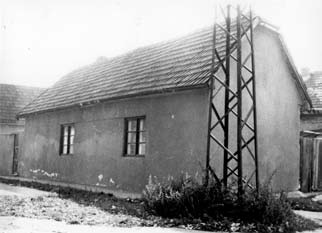In the protocol of the Serbian Orthodox Church of the Holy Ascension of the Lord in Subotica, it was noted that Aksentije Marodić was born on February 20, 1838, from Father Maksim, tailor and mother Ljubica, in a house that still exists in Vatroslav Lisinski No. 9 Street today.
Aksentije Marodić lived in Subotica, until his thirteenth year (1851). After completing two grades of gymnasium in his hometown, his father sent him to Stent to learn a painting craft at the then famous “moler” of Petar Pilić, with whom Novak Radonić was victimizing. Marodić spent four years with Pilic from 1851 to 1855, then went to Karlovo (now Novo Miloševo) near Nikola Aleksić, who painted the iconostas there. Aleksić is a student of Ars Teodorovic, a Viennese pupil, the most prominent Serbian classicist, as a painter of icons, a typical representative of the Biedermeier style. After only a year, Marodic returns to the Chick in Sent, which has become ill.
For the next two years from 1856 to 1858 he worked in Subotica. Among the most important works of the “Subotica period” are the portraits of the couple Manojlović (today at the Municipal Museum in Subotica), where the influence of Petar Pilić is obvious.
In 1858 he worked in Stari Becej. In the search for the work of those years, he moves on the line Bečej-Novi Sad-Subotica. Every job accepts, renews old icons. Perhaps he took out the coating of the Alexandrian iconostasis from 1766. In those years, the influence of Petar Pilić is released and falls under the influence of Nikola Aleksić. It is still unclear how the interest in Renaissance themes appeared during this period. Under the influence of Italian masters he makes plans for two medals: “One hundred years since the birth of Sava Tekelija” and “Death of Patriarch Rajčić”. From this creative period, the portrait of Jovan Jovanović comes in 1862.
At the beginning of the sixties, on the incentive of Novak Radonić, Marodić began collecting funds for his studies in Vienna, in “Mecca” of Serbian painters. Dr. Bogoljub Djordjevic accepted to collect donations among the citizens of Subotica and Staro Bečej. In Subotica, the call did not encounter the expected response, as an anonymous correspondent from Staro Becej sends a harsh reproach over ignorance through the “Serbian Journal” (1861/98). It is not known which amount was collected. He applied for a scholarship from the city of Subotica on February 8, 1862, but unfortunately there was no record of whether he received it.
In Vienna, he was enrolled in a preparatory course in 1861, under the number 806. When he spent all his money, in September 1862, he returned to Subotica.
After returning on September 22, 1862, he again begged the city for help. The city awarded him a scholarship of 100 forints, for the entire duration of the studies. He completed the studies in 1866 and thus became the first Akademic educated painter, a native of Subotica. In January 1867, in Subotica, from that period we left one copy of Van Dyk and the icon of St. Nicholas in the Orthodox Church. In those years, he went to Vienna, then to Venice, where Italian masters leave an indelible influence on him.
The contract with the Kovilj monastery in 1870, according to which, for the iconostasis of the Church of the Holy Archangels Gabriel and Michael, make 52 icons on the canvas, the first major career career. The production period was six years, for a 10,000 forint award. The advance payment for work in the Kovilj monastery covered travel expenses for Italy and Germany. He is exhibiting in Zagreb at the first, real art exhibition in 1874. On a trip he meets Bishop Štrosmajer to whom he presents one picture.
In the mid-seventies he started working on the iconostasis in Kovilje. He became a member of the literary department of Matica srpska in 1883. That year there are also portraits of the charity of this institution.
He settled in Kovilj, where he founded a family, bought a property, and dedicated himself to his leadership. His last oily work was from 1893.
In 1903, for the education of his son, he sold the property and moved to Novi Sad. He was elected member of the Society for the Serbian National Theater. Five years later, the Matica srpska’s calendar reproduces on its front page its self-portrait, which is also the last work. He was buried at the Novi Sad cemetery on March 20, 1909.
From the original look of the house, a part of the yard with a window is preserved. The house has been changed, on the street side there are two larger windows with a six-part split window. Only the roof is covered with a tile. On the back of the wall, the wall line breaks at an angle, and it is assumed that the corner part is upgraded. By inspecting the cadastral diameter from 1838 on this site there was a suvač. The house has two rooms with built-in kitchen part.
The object itself has no architectural value.
BIRTH HOUSE OF AKSENTIJE MARODIĆ


0 comments on “BIRTH HOUSE OF AKSENTIJE MARODIĆ”